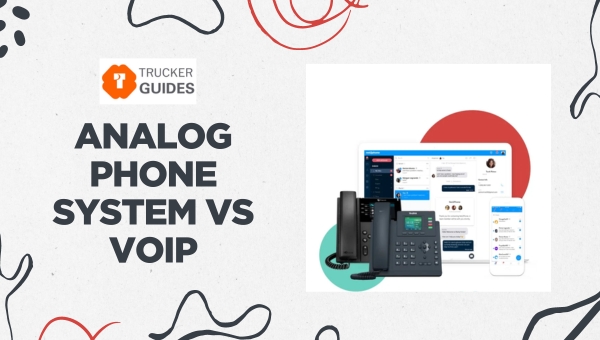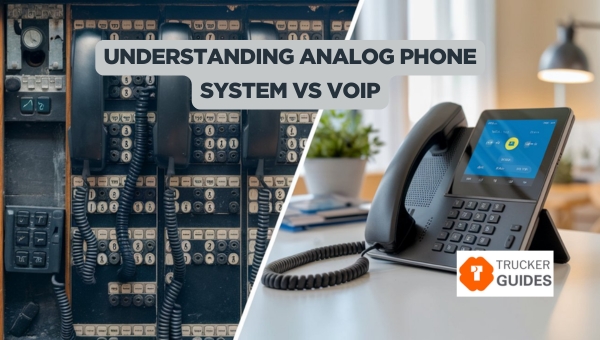Analog Phone Systems vs VoIP [Top Choice for 2024]


The basics of Analog Phone Systems vs VoIP systems is crucial. VoIP or Voice over Internet Protocol, allows you to make voice calls using a broadband internet connection instead of a traditional phone line.
This means that VoIP converts your voice into digital data, which is then transmitted over the internet. On the other hand, analog phone systems, also known as Plain Old Telephone Service (POTS), use a standard phone line to transmit voice signals. These signals travel as analog waves directly over copper wires.
VoIP is popular for its flexibility and advanced features. It allows users to make calls from various devices, including computers and smartphones, making it an optimal choice for modern businesses. Analog systems, while seen as more traditional, have their own set of strengths.
The differences between analog phone systems and VoIP (Voice Over Internet Protocol) is essential for businesses. Analog systems transmit voice signals over copper wires, offering reliable but limited features.

VoIP uses the internet to send voice data, providing advanced functionalities like video conferencing and lower costs. VoIP systems are more scalable and flexible, allowing for easy adjustments as business needs change.
Also Read: Best Free Bookkeeping Software [Top 5 Picks You Need to Try!]
Both VoIP and analog phone systems have their unique advantages, catering to various communication needs.

Understanding these benefits helps individuals and businesses make informed decisions about their telecommunication solutions.
VoIP systems offer several notable benefits compared to traditional phone systems:
Analog phone systems, though considered traditional, offer specific advantages in certain contexts:
Also Read: 8 Best Trucking Factoring Companies
When it comes to choosing between VoIP and analog phone systems, it is crucial to understand how they differ.

Let’s explore the key differences in installation and setup, maintenance and support, cost analysis, features and integrations, reliability and call quality, and security considerations.
| Feature | Analog Phone Systems | VoIP Phone Systems |
|---|---|---|
| Technology | Uses traditional copper wires to transmit voice. | Transmits voice data over the internet as data packets. |
| Installation Cost | High setup costs, typically $50-100 per line. | Low or no setup fee; can be installed in minutes. |
| Monthly Costs | Higher monthly service fees and call rates. | Lower rates, especially for long-distance and international calls. |
| Features | Limited features (e.g., call waiting, hold). | Advanced features like video calls, call forwarding, voicemail to email, and more at no extra cost. |
| Flexibility | Fixed to physical locations; difficult to relocate. | Highly flexible; can make and receive calls from anywhere with internet access. |
| Maintenance | Requires onsite technician for maintenance; costly. | Maintenance handled by the provider; typically lower costs. |
| Reliability | Generally reliable with consistent call quality. | Dependent on internet stability; may experience outages but offers high uptime with good service providers. |
| Compatibility | Compatible with legacy systems (e.g., fax machines). | May require adapters for some legacy devices; more modern integrations available. |
| Security | Less vulnerable to hacking; more secure in some respects. | Potentially more susceptible to cyber threats but can implement strong security measures like encryption. |
When setting up your phone system, understanding the hardware requirements is essential. Whether you opt for VoIP or an analog system, knowing what you need can make the process smoother and more efficient. Let’s break down the specific hardware needed for each type.
| VoIP Hardware | Analog Hardware |
|---|---|
| Internet Connection | Telephone Lines |
| A strong and stable internet connection is crucial, as call quality depends on internet speed and stability. | These are the physical lines that connect the phone system to the public switched telephone network (PSTN). |
| VoIP Phones | Analog Phones |
| These can be physical phones designed for VoIP systems or softphones (software applications on computers/mobile devices). | These are the traditional phones that operate using analog signals. |
| Router and Modem | PBX System |
| A capable router and modem are necessary to handle VoIP traffic; a VoIP-specific router may be needed for better performance. | A Private Branch Exchange (PBX) system manages multiple phone lines within a business, connecting internal phones to the PSTN and providing additional features like voicemail and call forwarding. |
| VoIP Adapter | Wiring and Jacks |
| Converts analog signals to digital ones, allowing the use of traditional phones with VoIP systems. | Proper wiring and phone jacks are necessary for connecting all phones and the PBX system. |
| PoE Switches | Switchboard |
| Power over Ethernet (PoE) switches power VoIP phones without needing separate power cables. | Used in larger setups to manually connect calls within the system. |
Also Read: The 30 Major Causes Of Failure
Cost Considerations
Feature Requirements
Reliability Needs
Security Priorities
After comparing analog phone systems and VoIP, it’s clear that VoIP offers significant advantages for businesses looking to modernize their communications. The cost savings alone are substantial, with small businesses able to save up to 40% on local calls and 90% on international calls by switching to VoIP.
Additionally, VoIP provides a wealth of advanced features like video conferencing, virtual phone numbers, and call recording without requiring expensive additional hardware.
The scalability and flexibility of VoIP systems make them ideal for businesses of all sizes, allowing for easy addition or removal of users and lines without costly equipment and wiring.